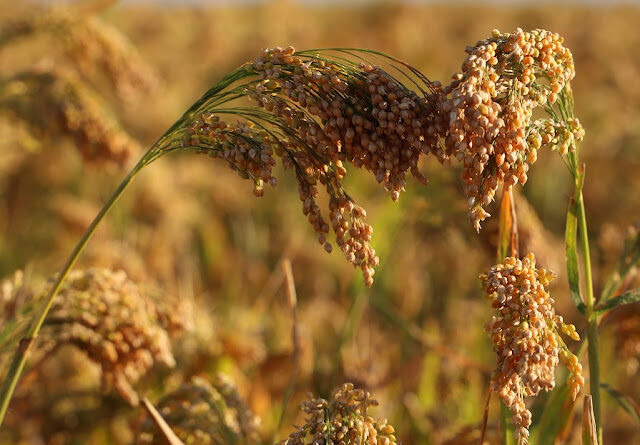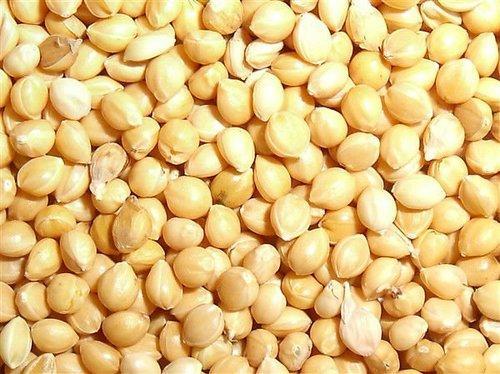Proso Millet or Cheena Cultivation; A Complete Information Guide
Proso Millet or Cheena Cultivation; A Complete Information Guide
Cheena or proso millet (Panicum miliaceum L.) belongs to the family Poaceae It is an important minor millet grown in India Proso millet is an erect herbaceous annual that grows up to a height of 45 cms Proso crop is able to evade drought by its quick maturity. Being a short-duration crop (60-90 days) with relatively low water requirement. this escapes the drought period and, therefore, offers better prospects for intensive cultivation in dryland areas.
Common Names of Proso Millet
Bengali : Cheena
Gujarati: Cheno
Hindi: Chena; Barri
Kannada : Baragu
Nutrient Value of Proso Millet or Cheena;
|
Nutrient |
Value |
Nutrient |
Value |
|
Moisture |
8.7 g |
Magnesium |
114 g |
|
Protein |
11 g |
Potassium |
195mg |
|
Fat |
0.7 g |
Phosphorus |
285 g |
|
Fiber |
8.5 g |
Vitamin C |
1.6 mg |
|
Carbohydrate |
72.8 g |
Vitamin B3 |
4.72 mg |
|
Calories |
378 K cal. |
Vitamin B5 |
0.85 mg |
|
Calcium |
8.0 g |
Vitamin B6 |
0.38 mg |
|
Iron |
3.0 g |
Vitamin B9 |
0.85 mg |
Climatic Requirements for Proso Millet or Cheena Crop;
Proso millet or Cheena is a crop of warm climate. It is extensively cultivated in warm regions of the world. This crop has high resistance to drought and can be easily cultivated in the region where there is scanty rainfall. Proso millet can withstand water stagnation conditions up to some extent. It is a hardy crop that completes its life span in a short span of time.
Soil Requirements for Proso millet or Cheena Crop;
Proso millet or Cheena can be grown both in rich and poor soils, having variable textures, ranging from sandy loam to clays of black cotton soils. coarse sands are not suited for cheena cultivation. Well-drained loam or loam soils free from tiny stones and rich in organic matter content are ideal for cheena cultivation.
Important Varieties of Prosomillet or Cheena Crop ;
|
Important Varieties of Proso Millet |
Suitable for |
|
Co-5, TNAU 151, TNAU 164, TNAU 145, TNAU 202, CO 4, K2, CO 3,CO 2, GPUP 21, GPUP 8 |
Tamil Nadu |
|
PRC 1, TNAU 145, 164, 151, CO 4 |
Uttrakhand |
|
GPUP 8 and GPUP 21, TNAU 145, 164 |
Karnataka |
|
BR-7, TNAU 164, 145, PR 18 |
Bihar |
|
Sagar, Nagarjuna, CO 4, CO 3 |
Andhra Pradesh |
Rotation and Mixed Cropping;
Proso millet or Cheena fits well in low, as well as high-intensity rotations:
2) Cheena-lahi taramira
3) Maize–toria-wheat-cheena
Field Preparation for Proso millet or Cheena Cultivation ;
Soon after harvesting the previous crop, the field should be ploughed to expose the soil to the sun and enable it to retain more moisture. With the onset of the monsoon, the land should be harrowed two to three times and then finally leveled. When it is being grown during summer, one irrigation should be given prior to land preparation. As soon as the soil ready for cultivation conditions, the seedbed should be prepared by running harrow or desi plough thrice followed by planking. Proso Millet Cheena requires a very firm and clean seedbed but it poorly respond to deep ploughing.
Seed and Sowing of Proso Millet or Cheena Crop;
seed should be treated with organo-mercurial compounds like Agrosan G.N. or Ceresan at the rate of 2.5 g per kg of seed before sowing.
(1) Time of Sowing
As a Kharif crop, cheena should be sown in the first fortnight of July with the onset of monsoon rains and as a summer crop, it should be sown by the middle of April. During summer, it would be desirable to sow cheena as soon as the harvesting of the Rabi crop is over.
(2) Seed Rate and Method of Sowing
Cheena can be sown by broadcasting or by drilling seeds in furrows 3-4 centimeters deep. Row-to-row distance should be kept at 25 centimeters and plant-to-plant at 10 centimeters. Line sowing ensures better germination, cuts down seed requirements, and facilitates intercultural operations Depending upon the method of sowing, 8-12 kg seed is required for sowing one hectare of land.
Manures and Fertilizers Requirement; 
Water Management in Proso Millet or Cheena Crop ;
Proso millet or Cheena sowed during Kharif season, generally does not require any irrigation. But, at tillering stage, if a dry condition prevails for a long time then one irrigation must be given to enhance the yields.
Weed Control in Proso Millet or Cheena Crop ;
For getting high yield and minimizing loss of soil moisture and nutrients, the field should be kept weed-free for up to 35 days’ stage Two weedings at an interval of 15-20 days would help control it weeding may be done with a hand hoe or wheel hoe.
Pest and Diseases of Proso Millet or Cheena Crop;
Head smut (Sphacelotheca destruens) is a common disease of cheena The affected panicles become elongated and thickened. The rupture before harvest. This is a seed-borne disease and can be by treating seeds with organo-mercurial compounds like Ceresa rate of 3 g per kg of seed or hot water treatment (soaking Seeds water at 55°C for 7-12 minutes).
Sometimes bacterial streak is also noticed. It can be controlled by the seed treatment with 5% magnesium arsenate at the rate of one gm of the chemical in one kg of seed.
b) Insect Pests Management;
Among insects, shoot fly is important for this crop. Shoot fly damages the crop in the seedling stage.
Harvesting and Threshing of Proso Millet or Cheena Crop;
Cheena is ready for harvest after 65-75 days of sowing in most of the varieties. Harvest the crop when it is about to mature. The seeds in the tip of upper heads ripe and shatter before the lower seeds and later panicles get mature. Therefore, the crop should be harvested when about two-thirds of the seeds are ripe. The crop is threshed with hand or bullocks.
The yield of Proso Millet or Cheena Crop;
With an improved agronomic practice, it is possible to harvest 20-25 of grain and 50-60 quintals of straw per hectare.




Pretty nice post. I simply stumbled upon your weblog and wanted to
say that I have really loved browsing your weblog posts.
In any case I will be subscribing on your feed and I am hoping you write once more very soon!